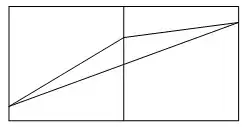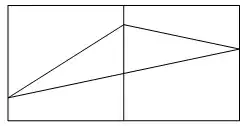Choose $3n$ independent uniformly random points in a disk with perimeter $x^2+y^2=1$. Label the points $P_1,P_2,P_3,\dots,P_{3n}$ in order of increasing $x$-coordinates. Form triangles $\triangle P_1P_2P_3,\space \triangle P_4P_5P_6,\space \dots,\space \triangle P_{3n-2}P_{3n-1}P_{3n}$.
Here is an example with $3n=21$.
What does the total area of the triangles approach as $n\to\infty$ ?
I did a simulation of $100$ trials with $3n=99999$, and the average total area was $0.318343178$. This number multiplied by $\pi$ is approximately $1.00010$, so I conjecture that the answer is $1/\pi$.
My attempt
I considered a simpler related question: What is the expected area of a triangle with vertices $(1,a_1),(2,a_2),(3,a_3)$ where the $a$ values are independent uniformly random real numbers in $[0,1]$ ?
The probability that $a_2$ is between $a_1$ and $a_3$ is $1/3$.
We have $\mathbb{E}(\max (a_1,a_2,a_3)-\min (a_1,a_2,a_3))=\frac12$ (explanation). The left and right sub-triangles share a vertical side, which in this case has expected length $\frac18$. So the expected area of the triangle is $2\times\frac12\times\frac18\times 1=\frac18$.
The probability that $a_2$ is not between $a_1$ and $a_3$ is $2/3$.
Again we have $\mathbb{E}(\max (a_1,a_2,a_3)-\min (a_1,a_2,a_3))=\frac12$. The left and right sub-triangles share a vertical side, which in this case has expected length $\frac38$. So the expected area of the triangle is $2\times\frac12\times\frac38\times 1=\frac38$.
So the overall expected area of the triangle is $\frac13\times\frac18+\frac23\times\frac38=\frac{7}{24}$. This value is supported by a simulation.
In the original question, the triangles are not limited to a rectangular box of height $1$, but rather are limited to a unit disk, which has an average height of $2\int_0^1\sqrt{1-x^2}\mathrm dx=\frac{\pi}{2}$. The rectangle and the disk have the same width, but in the disk there are horizontal gaps between neighboring triangles, so we multiply by a factor of $\frac23$. So the total area of the triangles in the disk should approach approximately $\frac{7}{24}\times\frac{\pi}{2}\times\frac23=\frac{7\pi}{72}\approx 0.30543$. This is slightly less than $\frac{1}{\pi}\approx 0.31831$. The difference may be due to the fact that the $x$-coordinates of the points in the disk do not have equal spacing.
EDIT:
I made a mistake in my simulation. Using the shoelace theorem, the area of the triangle with vertices $(x_1,y_1),(x_2,y_2),(x_3,y_3)$ is $\frac12|x_1y_2-x_2y_1+x_2y_3-x_3y_2-x_1y_3+x_3y_1|$, but I was accidentally using $\frac12|x_1y_2-x_2y_1+x_2y_3-x_3y_2-x_1y_3+x_\color{red}{1}y_1|$.
After correcting, my simulations suggest the answer is approximately $0.320$, which agrees with @Rei Henigman's answer. So I no longer think my conjecture is true, but I would still like to know if the limiting area of the triangles has a closed form.
I also did a (correct) simulation using a square lamina instead of a disk, and it seems that the proportion covered by the triangles is about $0.102$, which seems to match the proportion in the disk.
Context
This question was inspired by the question "A disc contains $n$ random points. Each point is connected to its nearest neighbor. What does the average cluster size approach as $n\to\infty$?".


